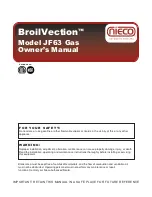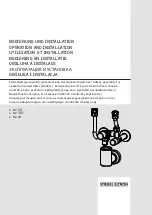
37
NOTE
Please refer to 3 - 3E and use the appropriate PPE when
carrying out any of the actions or procedures contained within
this section.
8.1 CHECKING APPLIANCE OPERATION
When carrying out any repairs or servicing to the appliance,
the relevant commissioning procedure must be undertaken to
ensure the continued safe operation of the appliance. Particular
attention should be made to ensure gas tightness, water
tightness and the electrical integrity of the appliance.
8.2 APPLIANCE MODES OF OPERATION
NOTE
There must be sufficient
system water pressure (min. 0.5 bar)
to ensure the water pressure switch is activated. If there is in-
sufficient system pressure the pump and fan will be prevented
from operating and the low-pressure fault code will be indicated.
8.2.1 MODE SELECTION IN THE OFF/RESET POSITION
When the mode selection is in the OFF/RESET position, the
following functions are active.
Active functions
:
• frost-protection system
• pump & actuator anti-block.
8.2.2 ON-BOARD FUNCTIONS
•
CO FUNCTION:
the CO function when activated, will allow the
appliance to run at CH maximum, DHW maximum or minimum
output whilst a combustion analysis check or a mechanical gas
valve calibration is being carried out. Whilst the CO function
is active, all other functions are disabled (minimum power
operating period, anti-cycle, set-point, etc). Once enabled,
the CO function will remain active for a 15-minute period, or
until the function is manually deactivated
•
FROST-PROTECTION:
this function is only active when
there are no requests for heating or HW. If the temperature
drops below 5°C, the boiler will operate on minimum power
until the temperature of the thermistors reaches 35°C for CH
and 55°C for DHW. Thereafter the pump & fan will over-run
for 30-seconds.
•
ANTI-CYCLE FUNCTION:
the anti-cycle function ensures the
burner remains switched off for at least 3-minutes after the
set-point hysterisis (set-point + 5-deg) for CH heat request.
•
PUMP ANTI-BLOCK FUNCTION:
when there has been no
heating or HW request for 24-hours, the anti-block cycle is
activated. The pump will be activated for a period of 30-sec-
onds.
•
ACTUATOR ANTI-BLOCK FUNCTION:
when there has been
no heating or HW request for 24-hours, the anti-block cycle
is activated. The diverter
valve actuator will motor briefly to
the heating position, and then back to the DHW position. The
pump will run briefly.
•
DHW PRE-HEAT FUNCTION:
when the DHW pre-heat func-
tion is enabled, the appliance will light periodically to maintain
the temperature of the DHW heat exchanger. When the
DHW thermistor and the primary thermistor fall below 35°C
and 55°C respectively, the boiler will fire on m25%
power until the primary thermistor exceeds 55°C. Thereafter
the pump will over-run for a period of 30-seconds.
8.2.3 HEATING MODE
With the mode selection in the heating & hot water position
and any additional controls (time clock, programmer, room
thermostat, etc.) calling for heat, the appliance will operate
in the heating mode. The pump and fan will be activated via
the flow temperature sensor. When the fan is sensed to be
operating correctly (tacho signal), the ignition sequence com-
mences. Ignition is sensed by the electronic circuit to ensure
flame stability at the burner. Once successful ignition has been
achieved, the electronic circuitry increases the gas rate to 75%
for a period of 15 minutes.
The speed of the fan and therefore the output of the boiler is
determined by the temperature of the water sensed by the flow
temperature sensor, consequently a high temperature at the
flow sensor results in a lower fan speed.
As the water temperature increases, the temperature sensors
– located on the flow pipe of the boiler – reduce the fan speed
via the electronic circuitry. Depending on the load, either the
water temperature will continue to rise until the set point is
achieved or the water temperature will fall whereby fan speed
will increase relative to the output required. When the boiler
has reached the set point (+ hysterisis), the burner will switch
off. The built-in anti-cycle device prevents the burner from re-
lighting for approximately 3-minutes. When the temperature
of the flow sensor falls below the set point (- hysterisis), the
burner will re-light.
NOTE
If the spark/sensing electrode does not sense ignition the appli-
ance will re-attempt ignition a further 4-times then go to lockout.
When the set-point has been reached (the position of the heating
temperature selector) as measured at the primary thermistor, the
appliance will begin the modulation phase whereby the fan and
gas valve will continuously modulate to maintain the set-point.
If the temperature continues to rise and exceeds the set-point
by 5°C (hysterisis), the burner will shut down. A new ignition
sequence will be enabled when the 3- minute anti-cycle has
been performed and the temperature at the primary thermistor
has dropped 5°C (hysterisis) below the set-point.
8.2.4 DHW MODE
With the selector switch in either the hot water only or heating
& hot water position, the appliance will operate in the hot water
mode whenever a DHW outlet is opened. A flow rate exceeding
2-litres per minute will activate the DHW flow switch whereupon
the pump and fan will be activated via the flow temperature
sensor. When the fan is sensed to be operating correctly (tacho
signal), the ignition sequence commences. Ignition is sensed
by the electronic circuitry to ensure flame stability at the burner.
Once successful ignition has been achieved, the electronic
circuit allows the gas rate to achieve the modulation value.
NOTE
When the request for heating and/or hot water has been satis-
fied, the appliance pump and fan may continue to circulate to
dissipate any residual heat within the appliance.
ATTENTION
Gas type and appliance output
must be set
according to the
specific appliance specification. Vokèra accepts no responsi
-
bility if the gas type is not correctly adjusted according to the
respective appliance specification as detailed on the appliance
data badge.
8.3 CHECKING THE CO
2
AND ADJUSTING
THE GAS VALVE
THE GAS VALVE MUST BE SET-UP OR ADJUSTED WITH THE
AID OF A PROPERLY CALIBRATED FLUE GAS ANALYSER.
Isolate the appliance from the electrical supply and remove the
appliance casing as described in 4.5.
Set the flue gas analyser to read CO2 and insert the probe into
the flue analysis test point.
8.3.1 COMBUSTION CHECK
To carry out the combustion analysis, proceed as follows:
set the boiler to the OFF status by pressing button 1
Remove the screw and the cover on the air distribution box
(
A-B,
Fig. 45
).
Insert the flue gases analysis probe.
8 CHECKS, ADJUSTMENTS AND FAULT FINDING
















































